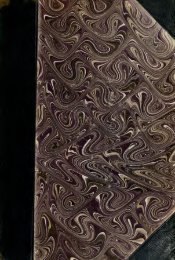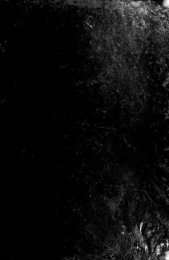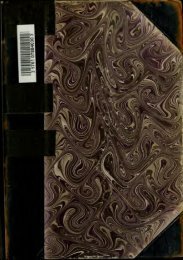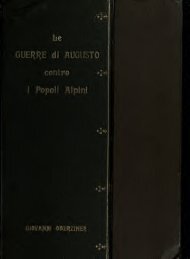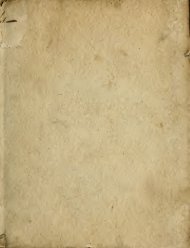Figurative uses of animal names in Latin and their ... - mura di tutti
Figurative uses of animal names in Latin and their ... - mura di tutti
Figurative uses of animal names in Latin and their ... - mura di tutti
You also want an ePaper? Increase the reach of your titles
YUMPU automatically turns print PDFs into web optimized ePapers that Google loves.
40<br />
dest<strong>in</strong>atis, non solum equi eliduntur et hom<strong>in</strong>es, sed etiamr<br />
hostium mach<strong>in</strong>amenta franguntur."^<br />
Ballistae et onagri, si a peritis <strong>di</strong>ligentissime temperentur,<br />
universa praecedunt, a quibus nee virtus ulla nee munim<strong>in</strong>a<br />
possunt defendere bellatores. Nam more fulm<strong>in</strong>is<br />
quicquid percusserit aut <strong>di</strong>ssolvere aut <strong>in</strong>rumpere con-<br />
suerunt.'^''*<br />
It is clear that the basis <strong>of</strong> the transfer <strong>of</strong> mean<strong>in</strong>g lies <strong>in</strong><br />
the similarity between the motion <strong>of</strong> the arm <strong>of</strong> the onager<br />
<strong>in</strong> <strong>di</strong>scharg<strong>in</strong>g missiles <strong>and</strong> the <strong>animal</strong>'s use <strong>of</strong> its h<strong>in</strong>d<br />
legs. The relation <strong>of</strong> cause <strong>and</strong> effect was aga<strong>in</strong> obscured<br />
by the Romans, who emphasized the likeness <strong>in</strong> results.<br />
The Greek ovaypm as a ballista is late <strong>and</strong> evidently reflects<br />
Lat<strong>in</strong> usage. Procopius speaks <strong>of</strong> it as though it were<br />
rather unfamiliar : a-tfievSovy Se avral (at firj-x^avai) eiaiv ifi~<br />
ipepsK Kal ovaypoi iiriKaKovvTai.^''^<br />
The ovaypoi <strong>of</strong> Suidas were defensive mach<strong>in</strong>es to seize<br />
assailants, the figure be<strong>in</strong>g due to the bit<strong>in</strong>g <strong>of</strong> the <strong>animal</strong><br />
Svaypoi firj'xavjjfiaTa, oi Xey<strong>of</strong>ievoi apvaye;, o'Cye apird^eiv tow<br />
irpoviovra'i eirt^aW<strong>of</strong>ievoi el'x^ov.<br />
Instead <strong>of</strong> the horse, the ancients regularly used as<br />
beasts <strong>of</strong> burden <strong>and</strong> for menial tasks <strong>animal</strong>s <strong>of</strong> the same<br />
genus as the onager, <strong>and</strong> so had ample occasion to note <strong>their</strong><br />
freedom with <strong>their</strong> heels. Pl<strong>in</strong>y recommends the adm<strong>in</strong>is-<br />
ter<strong>in</strong>g <strong>of</strong> frequent potions <strong>of</strong> w<strong>in</strong>e to check the familiarity<br />
<strong>of</strong> the mule <strong>in</strong> this respect : Mulae calcitratus <strong>in</strong>hibetur v<strong>in</strong>i<br />
crebriore potu.^®" In the same chapter, he pays his respects-<br />
to the unusually hard ho<strong>of</strong>s <strong>of</strong> the <strong>animal</strong>: duritia eximiapedum.<br />
Its dangerous heels enabled the wild-ass to make an al-<br />
liance with the lion<br />
:<br />
@rip7i


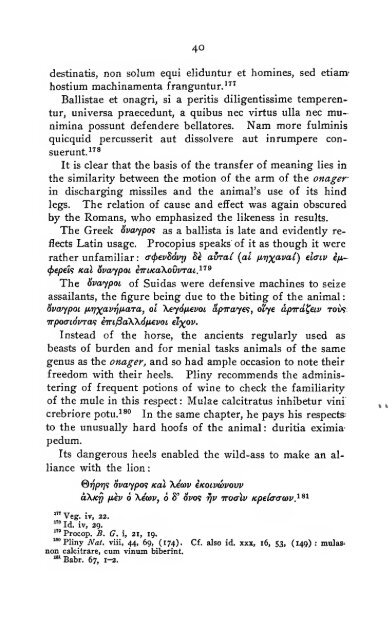
![Das Kriegswesen der Alten [microform] - mura di tutti](https://img.yumpu.com/21606999/1/167x260/das-kriegswesen-der-alten-microform-mura-di-tutti.jpg?quality=85)


